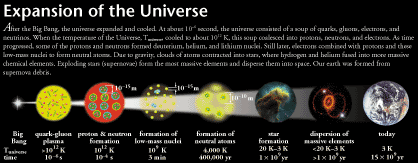Expansion of the Universe


The universe was created about 15 billion years ago in an event called the Big Bang. Around a microsecond after the Big Bang, the universe was populated predominantly by quarks and gluons. As the universe expanded, the temperature dropped. Eventually the universe cooled enough to allow quarks and gluons to condense into nucleons, which subsequently formed hydrogen and helium. Interstellar space is still filled with remnants of this primordial hydrogen and helium. Eventually, density inhomogeneities allowed gravitational interactions to form great clouds of hydrogen. Because the clouds had local inhomogeneities, they gave rise to stars, which collected into galaxies. The universe has continued to expand and cool since the Big Bang, and has a present temperature of only 2.7 Kelvin (K).
After the hydrogen and helium created in the Big Bang condensed into stars, nuclear reactions at the cores of massive stars created more massive nuclei up to iron in a series of nuclear reactions. Higher-mass nuclei were created at the end of the star’s life in supernovae explosions. These elements were scattered into space where they later combined with interstellar gas and produced new stars and their planets. Earth and all its occupants, animate and inanimate, are the products of these nuclear astrophysical processes.
|

